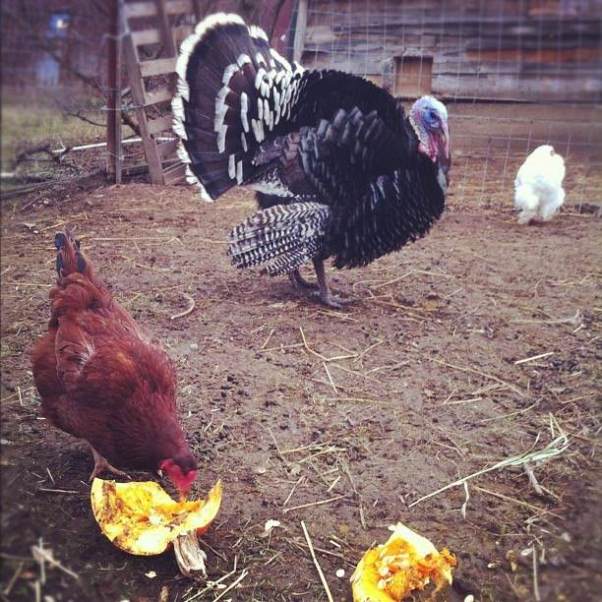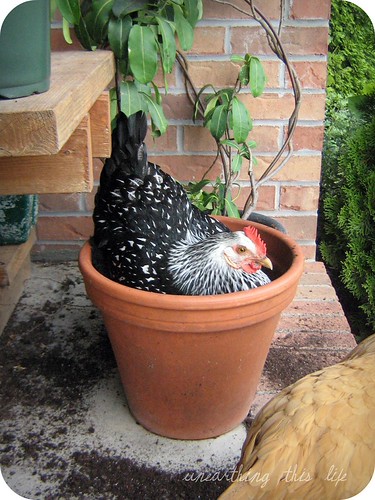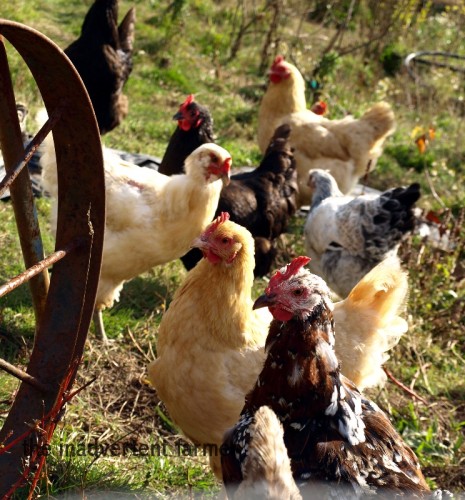I scratched my head a little when I found out we were doing ‘a day in the life of…’. I wondered if anyone would really want to know what the nitty gritty of my day was or would they just rather see some well chosen pictures and a little text…my usual blog fare.
In the hopes of not boring you to death…or worse yet…scaring you to death…here goes
A day in the life on Willowbrook Farm!
In the wee hours of the morning Baby Boy wakes up, and since he sleeps with us…don’t ask…I cannot ignore him. I roll over to nurse him and squint at the clock…3:43 am. Ughhhh, why after 5 kids have I not grown a backbone to just let him cry it out in the middle of the night? I am weak and at least 3 nights a weeks the little cherub makes me pay for my weakness by doing this middle of the night dance we do…nurse, sit up, tell mama he is hungry… I drag him and myself out of bed and into the kitchen…banana and water…his food of choice at now 4:08 am. I do not have to turn any lights on as my grow lights over my precious tomatoes and peppers light the downstairs with an eerie fluorescent glow. With banana and sippy cup in hand I plop the little guy on the couch, add some wood to the fire, gather an armful of blankets and settle with him in the corner of the couch. As he eats his banana with his eyes closed and humming to himself I wonder just how much I will miss this when he gets bigger.
5:30 am Sweet Girl comes out to the couch and snuggles up under the blankets, hubby says goodbye and is off to work. Sweet Girl tosses and turns and talks to herself while I in a semi-comatose state, I tell her to pipe down cause I’m sleeping…yeah who am I kidding? She is neither going to be quiet and I am certainly not getting any more sleep…
6am…we’re all up and I’m wandering the house wondering what to fix for breakfast, where is my bathrobe and where did I leave my sanity?
7am…Oatmeal with apples, cinnamon, yogurt, and raisins. Sweet Girl doesn’t like raisins but I do…
I tell her to be brave and eat around them.

Sometimes Baby Boy pours his own cereal…ughhh!

8:30 am…we’re all fed and dressed. Its time to feed the menagerie of animals…

The big guy always gets feed first because he is pushy and well he is the biggest!
He also needs to learn to chew with his mouth closed for goodness sake…

Next are the llamas and the goat

Baby Boy especially loves feeding the goat…
9:00…After feeding we go into the house and do a little laundry or some dishes. Next we start on home school. Bible, then reading.
We are in the middle of reading ‘On the Shores of Silver Lake’from the Little House on the Prairie Series. If ever I am tempted to complain about the work around here I just have to think of the Ingalls family and all their hard work and I am less likely to feel quite as sorry for myself…perspective is a marvelous attitude adjuster!
I always say just two chapters…four or five…or six…later we move on…
unless we decide to read some more!
10am or so…The kids play while I either sew on the current etsy order or fiddle around with editing pictures or something equally productive on the computer.
Sweet Girl and I usually start a batch of bread, cookies, or something of the sort just before lunch.

As the bread is rising or the cookies baking we eat lunch together…usually sandwiches and fruit…original huh?

Next comes cleaning up the baby from his sandwich…
After lunch we go and wander through the garden, check our mouse traps, look for newly emerged sprouts and head to the hen house to feed the girls and gather eggs…

After the big girls are fed we move on to feed, water, and otherwise just enjoy watching the little girls…

We have 10 aruacana chicks.
As the kids play outside I wash the eggs and start another load of laundry and try to remember to start the dishwasher so we will have clean dishes for dinner that night.
I go outside to check on the kids…

Sweet Girl can often be found being artistic with sidewalk chalk…

Baby Boy is all about his car and big wheel…
I usually take my camera with me when I go outside just in case…

Just in case pristine white crocus are just dying to have their pictures taken!
Baby Boy usually takes a short nap around 1pm
I also try to get done at least some kind of garden project when the weather permits. I am in the middle of building two tunnels for the garden, actually one is done and planted with cabbage, lettuce, brocolli and kale ,while the other is taking up room in the garage…sorry honey!
Note: This is something I see all day long when I look down…

We are working on puppy manners…so far, we are losing!
Around 4pm we go in and start dinner. Sweet Grace does some kind of handwriting, thank you notes, cards, etc. while I rack my brain to come up with something that is quick, nutritious, inexpensive and quick for dinner. Soup or pasta often fit the bill…both goes perfectly with homemade bread.
Although today I actually made a huge calzone, spinach and cheese, for dinner.

6pm dinner with hubby and kids.
6:30 clean the kitchen and fold some laundry while hubby plays with the kids
7:30 have worship and visit with the kids
8pm bedtime for Sweet Girl…daddy does this, brush teeth, put on pajamas, and then reads with her. They are reading ‘The Secret Garden’ even daddy likes this one…unlike Anne of Green Gables which he did not…too girlie and too wordy…in his opinion!
While sister is going to bed Baby Boy runs around the house like a crazy kid trying to avoid getting his jammies on. I finally nab him and squeeze him into his dinosaur pj’s while he make growling noises like a T-Rex…or his version of one. As I try to pin down the squirming baby I wonder how it is that hubby gets to read A Secret Garden in the quiet of the bedroom while I’m stuck with the wild child….I call for a re-vote!
I finally get the kid ready, brush his teeth while he giggles and spits toothpaste on me. We settle into the rocking chair and read a couple of his favorite books. He starts yawning…finally…I nurse him and he finally nods off…its around 9pm.
Sometimes I turn on the tv and watch something mindless but sometimes I just sit in peace and enjoy the fire…
10pm Hubby and I look at each and agree that if we don’t go to bed right now we will be soooo very sorry in the morning…
Oh yeah I forgot to let the puppy out!
I let the puppy out, go brush my teeth and wash my face, then go let the puppy back in.
I pass the laundry room on the way to bed and must throw just one more load in…
Pass the kitchen next and decide to make hubby’s lunch for tomorrow….
Going by my growing area I must stop in and check on my tomatoes and peppers…
Finally make it back to the bedroom, hubby is asleep…Baby Boy is asleep…Sweet Girl is asleep…
I am tempted to stay up and enjoy the quiet, but I know better…
3:43 comes awfully darn early in the morning!!!
Read Full Post »


















































